In 2025, platinum has become an appealing and often overlooked investment. It is rarer than gold, has a higher melting point, more high-tech uses, and is up over 45% year-to-date — significantly outperforming every other precious metal this year.
Platinum is also in the midst of a significant supply crisis as demand continues to outpace world reserves. According to mining publication, Discovery Alerts, platinum is confronting a ‘perfect storm’ of converging supply factors. “Years of underinvestment in mining capacity combined with operational challenges in South African mining have constrained supply just as demand is accelerating across multiple sectors.”[1]

While all the gold ever mined in the world would fit into a cube of roughly 72 to 75 feet on each side, all the platinum ever mined would fit into a cube of just 17 feet on each side.
In terms of non-investment uses, platinum’s melting point, according to the University of Bristol, is significantly higher than gold. “In its purest form it melts at 3214 degrees F, almost twice the temperature needed to melt 14 karat gold.”[2] This makes it suitable for a host of high temperature applications — particularly in industry, technology, energy and weaponry. Platinum’s unique characteristics, limited supply and many uses make a strong case for its undervaluation.
Catalytic Converters
Platinum is a critical component of catalytic converters. A catalytic converter is a mandatory device found in the exhaust system of all gas-powered cars. These ‘emissions control’ devices make auto engine pollutants less toxic.

“A catalytic converter lies between a car’s engine and its exhaust pipe. It contains catalysts to remove pollutants from the car’s engine, by converting them into harmless emissions.”[3] This specialized automotive device uses chemical reactions with precious metals like platinum to clean dangerous exhaust from automotive engines.
According to Thermo-Scientific,
“Catalytic converters are pollution control devices coated with chemicals and a combination of the platinum group metals (PGM) platinum (Pt), rhodium (Rh) and/or palladium (Pd). The PGMs are responsible for the conversion reactions that turn pollutants into harmless gases. Most present-day vehicles that run on gasoline, including more than 98% of new cars sold worldwide each year, as well as trucks, buses, trains, motorcycles, and planes have exhaust systems with a catalytic converter.”[4]
Over the last five years, automotive demand for platinum has been 29% to 42% of total platinum demand.[5] And as the adoption of electric vehicles faces challenges from the current administration’s rollback of climate initiatives along with disappointing EV sales — platinum automotive demand is forecast to remain robust.
Hydrogen Applications
Platinum also acts as a catalyst in hydrogen electrolyzers and fuel cells. The former produces “green hydrogen” as a clean fuel source while the latter generates electricity to power motors.
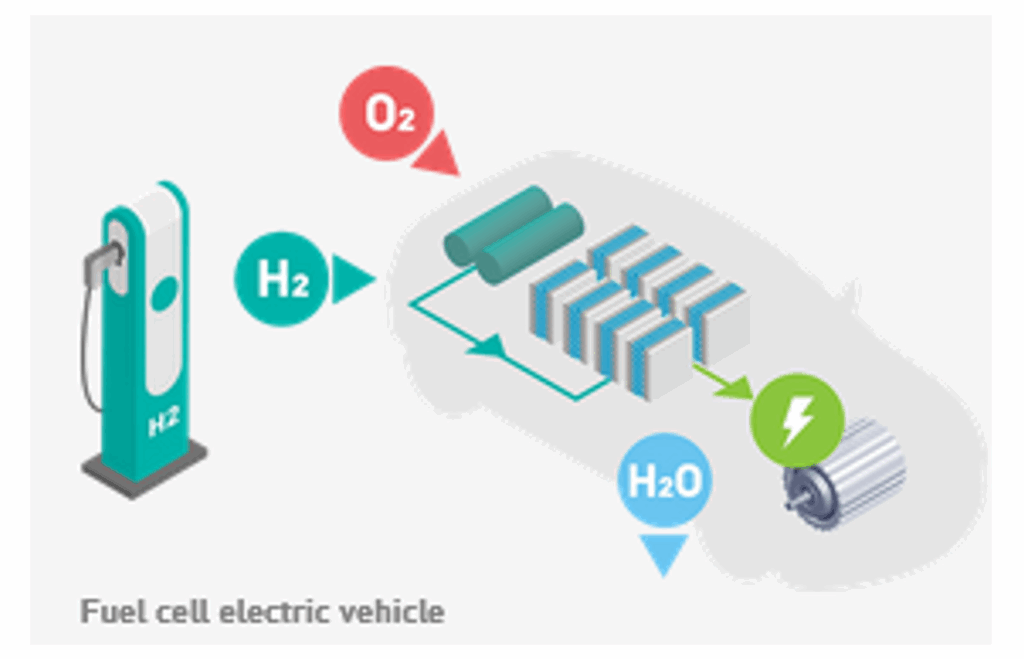
“Platinum’s role is particularly significant in proton exchange membrane (PEM) technologies, which are essential for both hydrogen production and utilization. PEM electrolyzers, which generate hydrogen by splitting water molecules using electricity, depend on the metal serving as a catalyst.”[6]
According to the World Platinum Investment Council, platinum is a critical component of hydrogen fuel cells which provide emissions-free power and a viable alternative to electric batteries.
Fuel cells in heavy-duty vehicles such as trucks and buses are currently leading the growing market for Fuel Cell Electric Vehicles (FCEVs).[7]
Hydrogen-powered trains are already in commercial use. Trucks and buses are currently in production while mass transport involving sea and air travel are in the testing and prototype phases.
Rising green energy demand and the fuel cell revolution, will propel the platinum catalyst market from a projected $1.2 billion last year to $2.5 billion by 2033. And it will be largely driven by both technological advancements and government mandates.[8]
Hydrogen energy is widely seen as a vital decarbonization tool and according to the International Energy Forum, “platinum’s role in the energy transition could lie in making clean hydrogen technologies commercially viable.”[9]
Defense and the Military
Modern military readiness incorporates precision jets, missiles, rockets, thermal and infrared technologies, and heat-seeking weapons — and platinum makes them all work.

According to Investing News, NATO’s increased defense spending commitment is shining a light on the role of platinum and other minerals deemed critical to modern weaponry and military technologies:
“Aircraft engines rely on platinum and rhodium for temperature sensing, while platinum is also used as a protective plating for turbine blades. In missile systems, platinum and iridium are incorporated into nose cones for their ability to withstand extreme heat. Military vehicles also draw on platinum for catalytic converters and infrared suppression systems, which help reduce thermal visibility against heat-seeking weapons.”[10]
On June 25, 2025, the heads of NATO agreed to raise their defense expenditure to 5% of their GDP annually by 2035, a dramatic increase from the previous 2% mark. This is a boon for platinum which is has emerged as a critical element of the modern war machine. Militaries around the world rely on Platinum Group Metals (PGMs) for critical vehicle and aircraft capabilities:
- Catalytic converters using platinum reduce emissions from military vehicles, meeting increasingly stringent environmental standards while maintaining operational capability
- Thermal signature suppression technology utilizing platinum coatings reduces vulnerability to infrared detection and heat-seeking weaponry—a critical survival feature in modern combat environments
- Temperature-sensing components made from platinum-rhodium alloys provide precise monitoring in extreme-temperature environments like jet engines and rocket motors
- Heat-resistant components incorporating various PGMs enable operation in conditions where conventional materials would fail, extending operational capabilities[11]
Platinum’s high melting point, extreme heat tolerance, conductivity and catalytic properties are essential for many defense technologies. It has proven to be a strategic metal for the national defense systems of NATO and most major military units around the world making it a critical component of war readiness.
Platinum is significantly less expensive than gold. It is also caught in a severe structural supply deficit as demand is growing across multiple high-tech categories including clean energy and military capability. This is why savvy investors are acquiring platinum coins, bars and even IRA approved bullion.

DID YOU KNOW?
- The Hope diamond, a famous sizeable blue-colored diamond, is set in platinum.
- King Louis XVI of France heralded platinum the “only metal fit for kings”.
- Just four mines (one in Russia and three in South Africa) account for 90% of the world’s platinum production.[12]
Contact Thor Metals Group at 844-944-THOR to obtain Investment-Grade Platinum
—
[1] https://discoveryalert.com.au/news/platinum-supply-squeeze-2025-south-africa-deficits/
[2] https://www.chm.bris.ac.uk/~paulmay/webprojects1997/JonathanT/info.htm
[3] https://matthey.com/science-and-innovation/knowledge-hub/what-is-a-catalytic-converter#sectionend-mbxz_
[4] https://www.thermofisher.com/blog/metals/new-reduced-platinum-catalyst-for-catalytic-converters/
[5] https://platinuminvestment.com/about/demand-drivers
[6] https://investingnews.com/hydrogen-economy-platinum-demand/
[7] https://platinuminvestment.com/about/hydrogen-demand
[8] https://www.ainvest.com/news/platinum-price-navigating-geopolitical-risks-green-energy-demand-shifting-market-2508/
[9] https://www.ief.org/news/energy-transition-to-trigger-huge-growth-in-platinum-for-hydrogen
[10] https://investingnews.com/nato-defense-spending-pledge-highlights-pgms/
[11] https://discoveryalert.com.au/news/platinum-group-metals-defense-aerospace-2025/
[12] https://www.thmarch.co.uk/insights/what-is-platinum-interesting-platinum-facts-and-uses/
There’s no doubt that the dollar’s role in the international monetary system is changing. In a world teeming with armed conflicts, soaring debt, market manipulation and what the World Economic Forum calls “an increasingly fractured global landscape,”[1] central banks are looking to protect their economies. The world’s leading monetary authorities are responsible for trillions of dollars in global bank reserves, and they’re increasingly swapping their greenbacks for gold in an effort to diversify their holdings and reduce economic risk.
The Dethroning of ‘King Dollar’?
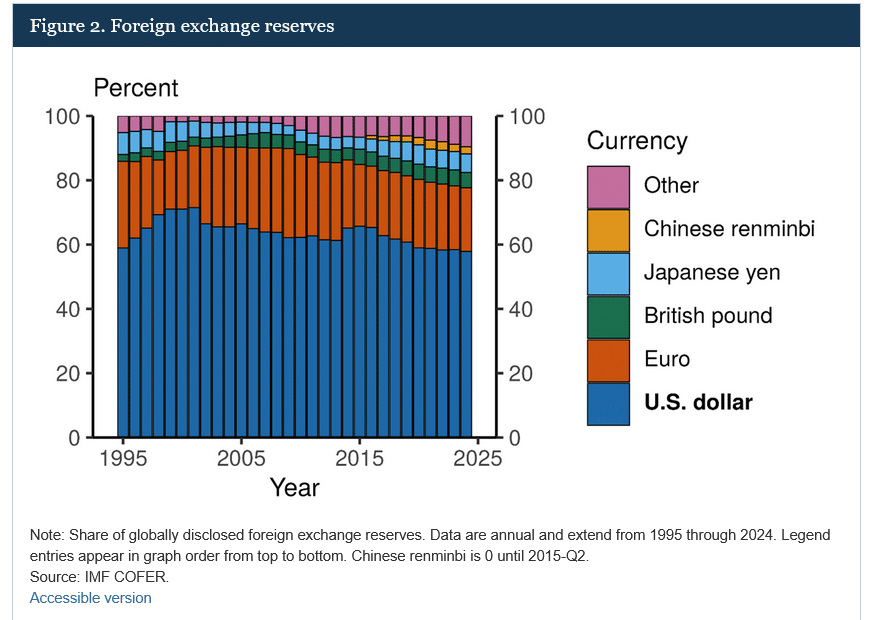
According to the Federal Reserve, the U.S. dollar represents about 58% of “disclosed global reserves” (2024) — and while it far surpasses foreign exchange reserves of other major currencies like the euro (20%), Japanese yen (6%), British pound (5%), and the Chinese renminbi (2%) — it has significantly declined from its peak of 72% back in 2001.[2]
Year-to-Date the dollar has fallen almost 9% in value, and this has gotten the attention of central banks looking to diversify their reserves to lower risk and reduce volatility. It has also prompted them to seek out higher yielding currencies and finite commodities like gold that traditionally have an inverse relationship with the dollar.
This shift reflects growing concerns about the greenback from its weakening safe haven status — to its changing role in the international monetary system. And for JP Morgan Private Bank, it also suggests a threat to U.S. exceptionalism.
“For decades, U.S. exceptionalism has been a cornerstone of global investing, powered by robust economic growth, tech dominance, high real (inflation-adjusted) yields and deep markets. Since the early 2010s, U.S. stocks have consistently outperformed, Treasuries have attracted steady demand, and the dollar has risen almost uninterruptedly … The tide may be turning. For the first time in years, the dollar looks to be unwinding its longstanding overvaluation, which could mean a 10%–20% decline over the medium term against major peers such as the euro and Japanese yen.”[3]
“The Damage Has Been Done!”
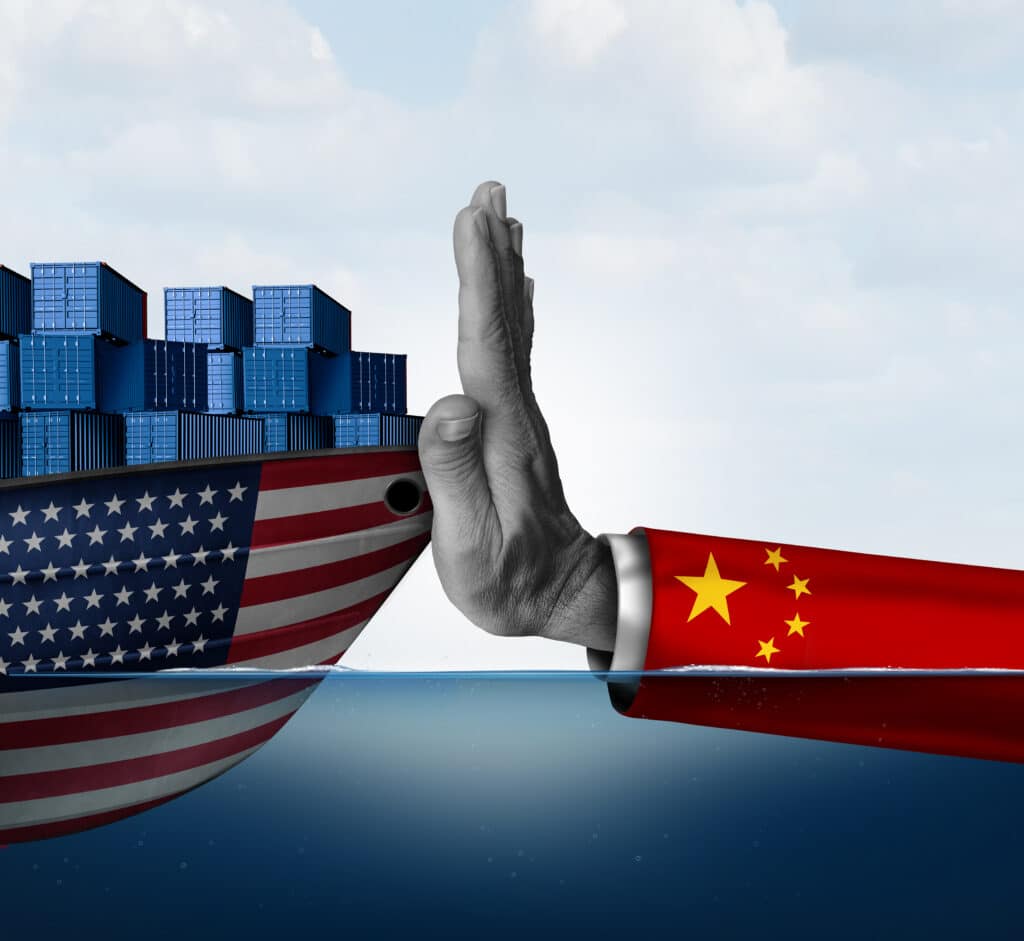
In the post-Cold War era most, major economies have feverishly amassed U.S. assets giving America “exorbitant privilege” effectively tilting the balance of economic power decidedly toward the United States.
But according to PIMCO, President Trump’s aggressive trade tactics have created added uncertainty and imbalances in the dollar-centric global financial system, reducing the attractiveness of American assets.
“With tariffs disrupting this balance, the financing of America’s twin current account and fiscal deficits may become more challenging unless there is fiscal support, as countries pursue greater economic and military self-reliance. The breakdown of longstanding global correlations could be painful for a global investor, who may be left wondering how many U.S. assets to own.”[4]
So, while Trump’s new tariff deals may be generating revenue and reducing the trade deficit with various countries, they may also be accelerating the decline of the dollar and setting the stage for a prolonged gold price surge. According to the head of foreign exchange research at Deutsche Bank, “The damage has been done. The market is reassessing the structural attractiveness of the dollar as the world’s global reserve currency and is undergoing a process of rapid de-dollarization.”[5]
The Dollar Loses Market Share
The U.S. has enjoyed immeasurable benefits of a dollar-dominated world from trade, to borrowing, to military power, and the imposition of crippling sanctions. According to the Atlantic Council, a strong dollar has not only been at the very heart of America’s superpower designation, it has also fostered global stability.
“Over the past eight decades, the status of the United States as an economic and geopolitical superpower and the role of the US dollar as the world’s dominant currency have reinforced each other. As a synonym for the dollar’s preeminent role in international currency transactions and foreign reserve holdings, dollar dominance has long been associated with the United States’ exorbitant privilege to finance large fiscal and current account deficits at low interest rates. This has helped the United States run a large defense budget and conduct extensive military operations abroad. In turn, the United States has used its military capabilities to support the free flow of goods and capital across the globe, boosting global growth.”[6]
But the dollar’s share of central bank reserves is falling. U.S. debt has just eclipsed $37 trillion and is on track to grow by $22 trillion over the next decade, and according to the Congressional Budget Office, Trump’s ‘Big Beautiful Bill’ will increase deficits over the 2025–2034 period by another $2.4 trillion.
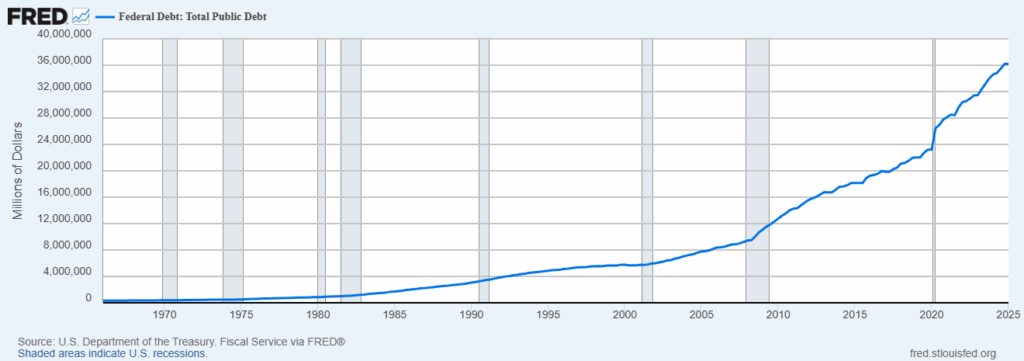
Is it any wonder that the dollar is losing market share? And its diminished capacity not only increases global uncertainty but the likelihood of economic chaos.
The Official Monetary and Financial Institutions Forum’s 2025 survey of 75 central banks and 15 public pension and sovereign funds with more than $7 trillion in combined assets — reveals the following:
- 96% of central banks flagged tariffs and trade protection as a main concern.
- 70% of central banks are increasingly worried about the US political environment
- 32% of central banks expect to increase gold holdings in the next 12–24 months, with over 20% forecasting the price to surpass $3,500 per ounce.[7]
The World Returns to Gold
The world’s central banks are stockpiling gold and have accumulated over 1,000 tons in each of the last three years, up significantly from the average of 400-500 tons over the preceding decade.[8]

The precious metal has also just surpassed the euro as the second largest global reserve asset in the world. And with the dollar down over 5% in the past year and gold up more than 37% — it is no longer just a hedge but the new face of fiscal privilege in the dramatically shifting economic world order.
To learn more about acquiring gold and for information on opening a precious metals retirement account visit: www.ThorMetalsGroup.com
[1] https://www.weforum.org/publications/global-risks-report-2025/
[2] https://www.federalreserve.gov/econres/notes/feds-notes/the-international-role-of-the-u-s-dollar-2025-edition-20250718.html#
[3] https://privatebank.jpmorgan.com/apac/en/insights/markets-and-investing/is-this-the-downfall-of-the-us-dollar
[4] https://www.pimco.com/us/en/insights/trade-wars-and-the-us-dollar
[5] https://www.theguardian.com/business/2025/apr/11/the-damage-is-done-trumps-tariffs-put-the-dollars-global-reserve-status-at-risk
[6] https://www.atlanticcouncil.org/content-series/atlantic-council-strategy-paper-series/why-the-us-cannot-afford-to-lose-dollar-dominance/
[7] https://www.omfif.org/global-public-investor-2025/
[8] https://www.gold.org/goldhub/research/central-bank-gold-reserves-survey-2025
While gold has been grabbing world headlines as it has set repeated price records, silver has quietly rallied to an 11-year high, shattering the $30/oz mark this month. It is one of the year’s best performing commodities and yet in relative terms, silver is cheap. It currently takes about 80 ounces of silver to buy 1 ounce of gold, compared with the 20-year average of 68.[1]

Silver’s story is steeped in history as the jewelry, food vessels, objets d’art, and coins of the ancients were all made from silver.
But it is also a metal with one foot firmly in modernity as a highly conductive catalyst that plays a critical role in the green revolution and the global transition to clean energy.
According to the U.S. Geological Survey, “of all the metals, pure silver has the whitest color, the highest optical reflectivity, and the highest thermal and electrical conductivity.”[2]
Could Silver Double or Even Triple?
Silver’s latest price forecasts range from $34-$35/oz to as high as $50/oz with some outlier predictions for a price surge of up to $100/oz based on rising industrial demand, growing supply deficits, and limited above ground stock. From 2021 to 2023, the Silver Institute estimates there was a cumulative deficit of 474 million ounces of silver, equivalent to 14,743 tons of the white metal.
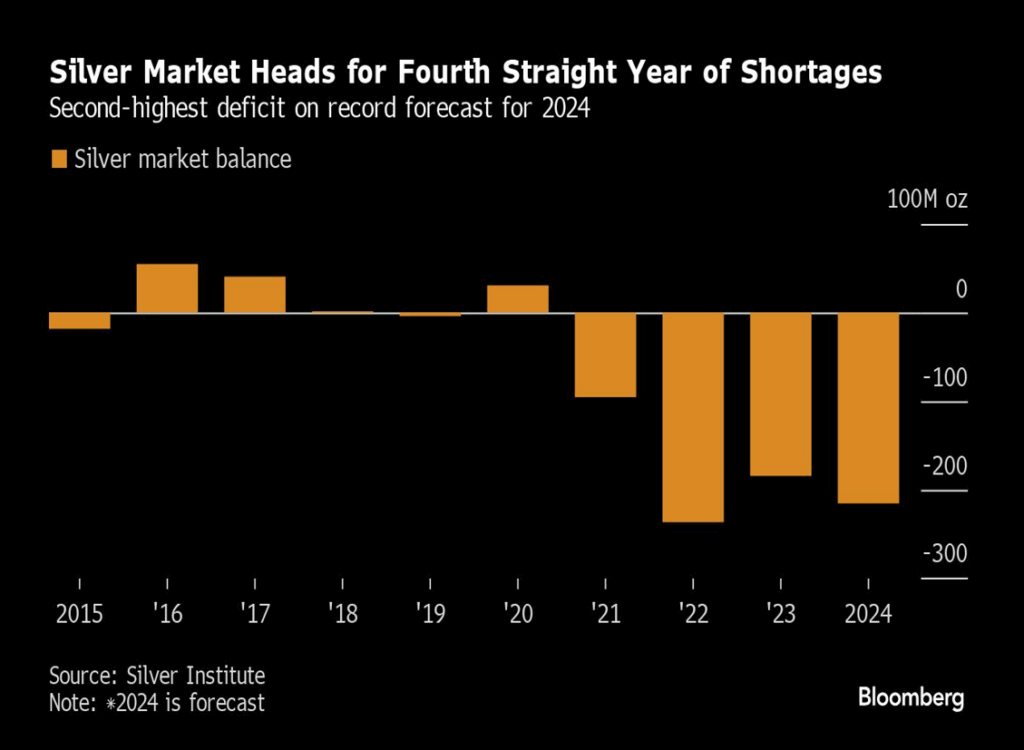
According to MarketWatch
“Forecasts pointing to a fourth straight yearly deficit in global supplies and a rise in demand to its second-highest level on record raise the potential for silver prices to rally, and even roughly double before the end of 2024.”[3]
Supply Challenges Keep Silver Undervalued
Most experts consider silver to be grossly undervalued based upon inherent and uncorrectable supply deficits. As mentioned, silver demand has outpaced supply for the past three years, and according to commodities research group CPM, silver supply is currently in a structural decline that cannot easily be reversed.
“The main issue is the deterioration in mine production, although scrap sources are falling as well. This is important because much of the bullion you and I buy comes from newly-mined silver. Secondary sales (bullion products that have been previously bought and sold) will always have a place in the industry, but to be prepared … mine production will need to be healthy and rising. It is neither of those things.”[4]
It’s important to remember that silver is rarely found in its pure form and excavating silver from the earth is a complex process of extracting and sifting mineral-rich rock and sediment (ore) via open pits and deep underground mines. Silver-bearing ores like copper, lead and zinc must then be crushed, ground, separated and chemically processed to derive pure silver.
This inherently arduous, expensive, and often inefficient process will only become more taxing since most of the silver that’s easiest to mine has already been reached. So, amid the greatest demand pressure in history, silver reserves are dwindling and that should drive silver prices higher well into the foreseeable future.
Investing News recently summarized the silver supply and demand challenges as follows:
“The thinning inventories that contributed to silver’s price gains through Q1 have been driven by the white metal’s increasing demand from industrial sectors. The biggest contributing sectors have come from the energy transition, particularly the production of photovoltaics and electric vehicles.”[5]
The Unstoppable Solar Army
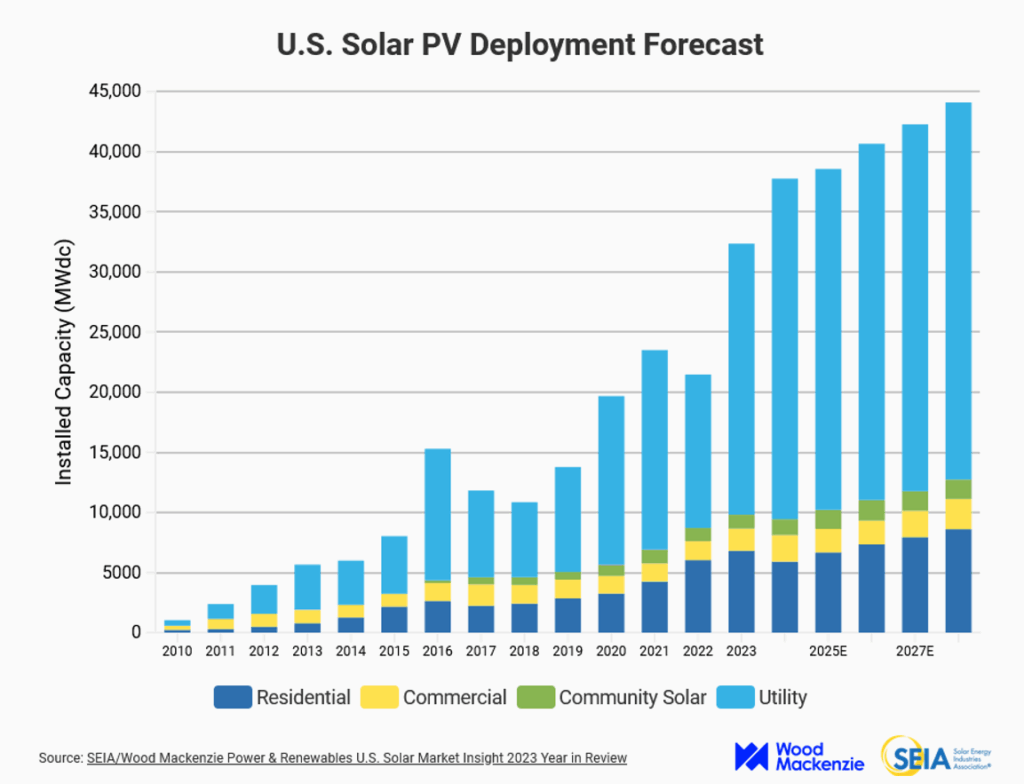
So where does silver go from here? In terms of green energy needs, demand looks elevated well into the end of the decade. Solar energy continues to boom, particularly in the U.S. The Solar Energy Industries Association predicts nothing but silver rooftops and sunshine ahead.
“The total US solar fleet is expected to quadruple over the next decade to 673 GW, as the Inflation Reduction Act provides key tax incentives and long-term certainty that will spark demand for solar and storage and accelerate the transition to renewable energy.”[6]
Breaking Price Barriers and Resistance Levels
Andrew Addison of Barron’s who has been charting silver’s price barriers, resistance levels and upsides for years, believes silver is ready for a dramatic breakout. “Once silver has a monthly close above $31, then my work would confirm upside projections to $45-$55.”[7]
He’s not alone. FX Empire recently stated that, “historically speaking, once we get above the $30 level, it [silver] is a market that tends to just take off to the upside.” And Forbes Advisor Benjamin Curry offers this advice, “It makes sense to invest in silver under certain market conditions. When supply and demand are out of balance is the right time to invest in silver.”
And with silver supply critically constrained and silver demand being inexhaustibly driven by expanding 5G networks, photovoltaics, and consumer electronics — the right time to buy appears to be right now.
AI Demand and Beyond
Global silver demand is expected to reach 1.2 billion ounces this year, the second highest level in recorded history, and there seems no end in sight for silver’s role in industry, manufacturing, renewable energy and beyond.
According to the Silver Institute’s April 2024 Newsletter, “Silver has many exciting new demand opportunities beyond its traditional applications and expanding role in the energy transition. For example, silver will become an indispensable material as artificial intelligence (AI) rises. End uses expected to incorporate silver in AI include transportation, nanotechnology, biotechnology, healthcare, consumer wearables, computing, and energy in data centers.”[8]
Contact Thor Metals Group at 844-944-THOR for information on Investment-Grade Silver
[1] https://www.mining.com/web/hot-commodity-silver-sets-pace-as-demand-and-deficit-drive-rally/
[2] https://www.usgs.gov/centers/national-minerals-information-center/silver-statistics-and-information
[3] https://www.marketwatch.com/story/it-may-be-silvers-turn-to-shine-after-the-gold-rush-to-record-high-prices-e119b3ec
[4] https://cpmgroup.com/update-new-silver-supply-is-drying-up-faster-than-death-valley/
[5] https://investingnews.com/daily/resource-investing/precious-metals-investing/silver-investing/silver-forecast/
[6] https://www.seia.org/solar-industry-research-data
[7] https://www.barrons.com/articles/silver-breakout-what-to-watch-cf9872ac
[8] https://www.silverinstitute.org/wp-content/uploads/2024/05/SNApr2024.pdf
Julian Assange, the founder of WikiLeaks, is known for his role in revealing classified information and confidential documents that shed light on government operations worldwide. Among the myriad of leaks that have drawn public and media attention, one significant revelation pertains to the U.S. government’s alleged gold suppression policy.
Through WikiLeaks, Assange exposed documents that hint at covert strategies employed by the federal government to manipulate gold prices, thereby maintaining the dominance of the U.S. dollar in global markets.
Background on Gold Suppression Policy
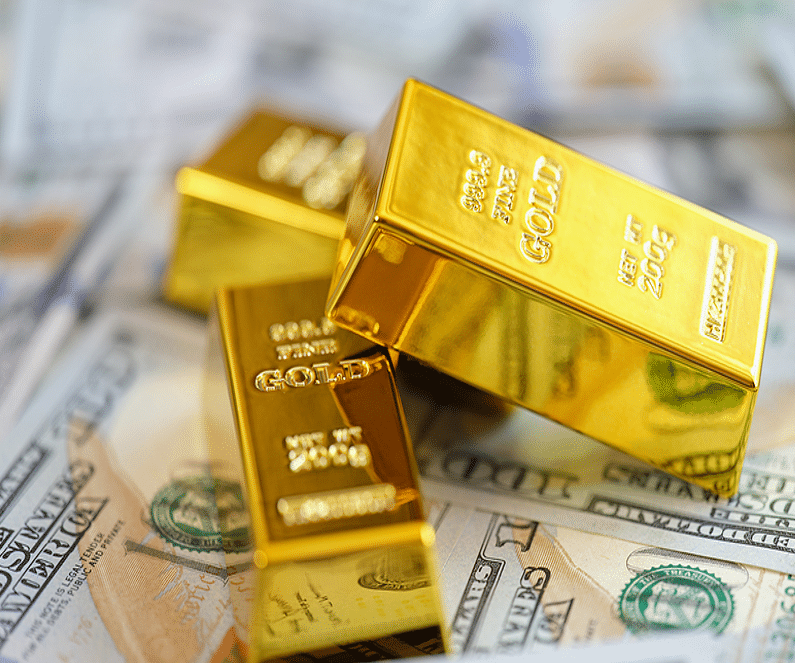
Gold has historically been a cornerstone of economic stability, serving as a hedge against inflation and a reliable store of value. Its significance in the global economy makes it a critical asset for investors and governments alike. The U.S. dollar, as the world’s primary reserve currency, has a unique relationship with gold. A rise in gold prices often signals a lack of confidence in fiat currencies, particularly the dollar. Consequently, a high gold price can undermine the dollar’s value and, by extension, the U.S. economy’s stability.
The alleged gold suppression policy posits that the U.S. government, along with major financial institutions, engages in activities to artificially control and suppress gold prices. This could involve tactics such as large-scale selling of gold reserves or derivative contracts to flood the market and lower prices. The aim would be to make the dollar appear stronger in comparison, sustaining its role as the leading reserve currency.
WikiLeaks, under Assange’s direction, published several documents that suggest the existence of such a policy. One of the most notable leaks was a series of diplomatic cables from the U.S. embassy in Beijing. These cables reveal discussions between U.S. officials and Chinese counterparts, highlighting concerns over China’s growing interest in gold as a way to diversify its reserves away from the dollar. The cables suggest that U.S. officials were worried about the potential impact of China’s gold purchases on the global gold market and, implicitly, on the dollar’s value.
WikiLeaks also released documents from the International Monetary Fund (IMF) that indicate discussions around gold price manipulations. These documents point to collaborative efforts between the U.S. and other Western nations to maintain control over gold prices, ensuring that they remained at levels favorable to the dollar.
Key Implications of the Revelations

The exposure of these documents by WikiLeaks has several significant implications. Firstly, it fuels the long-standing debate over the legitimacy of the gold suppression theory. While some economists and market analysts have long suspected government interference in gold markets, the leaked documents provided a semblance of validation to these claims. The idea that major financial powers could be manipulating gold prices to serve their interests resonated with many, particularly those skeptical of government transparency and accountability.
Secondly, the revelations have a profound impact on the gold market itself. Following the leaks, there was an increase in gold purchases by both private investors and central banks. The perception that gold prices were being artificially suppressed led to a surge in demand, as investors sought to acquire gold before potential corrections could occur. The increased demand put upward pressure on gold prices, ironically counteracting the alleged suppression efforts.
Assange’s Role and the Broader Impact
Julian Assange’s role in exposing the U.S. government’s alleged gold suppression policy underscores the broader mission of WikiLeaks: to promote transparency and accountability by unveiling hidden truths. By publishing classified documents, Assange aimed to inform the public about governmental actions that were conducted behind closed doors, without democratic oversight or consent.
The impact of these revelations extends beyond the financial markets and has sparked discussions on government secrecy and the balance between national security and the public’s right-to-know. Assange’s actions were praised by advocates of transparency and condemned by those who viewed them as reckless and potentially harmful to national interests.
The Hidden Mechanisms of Government
Julian Assange, through WikiLeaks, played a pivotal role in uncovering the U.S. government’s alleged gold suppression policy. The leaked documents provided insights into the covert strategies purportedly employed to manipulate gold prices, highlighting the intricate interplay between economic policies and global power dynamics. While the full extent and impact of these revelations continue to be debated, Assange’s work has undeniably contributed to the unmasking of the hidden mechanisms, policy manipulations, and monetary maneuvers that shape our world — and our economy.
Learn more about Thor Metals Group and get added insights on gold, silver, and market-moving financial news by visiting: www.ThorMetalsGroup.com